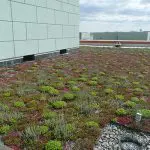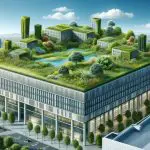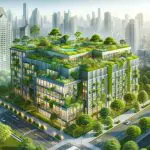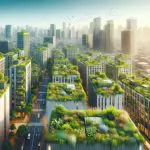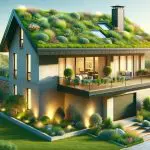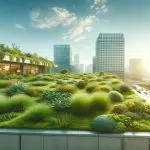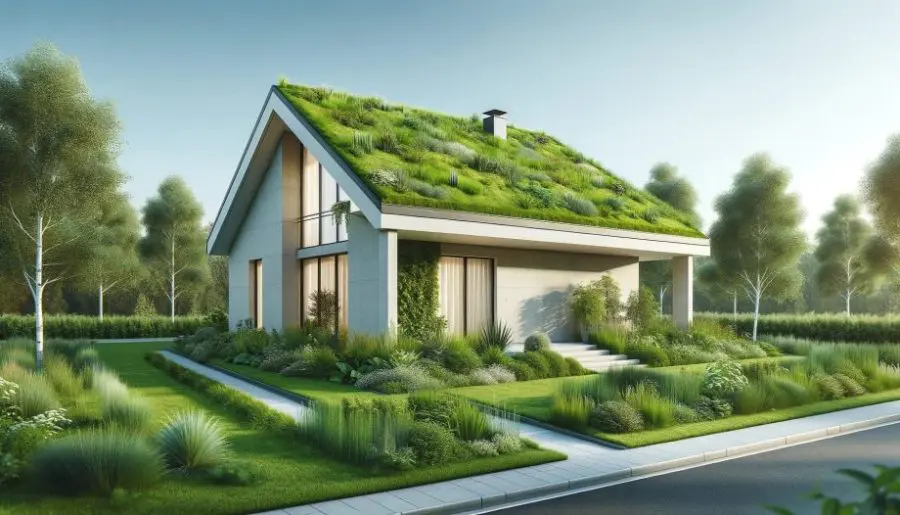
Discover what is a green roof and its amazing benefits! Uncover how these eco-friendly rooftops transform urban spaces into green havens.
Green Roofs Key Takeaways:
- A green roof is a layer of vegetation planted over a waterproofing system installed on top of a flat or slightly sloped roof.
- It’s designed for environmental benefits, including improved insulation, reduced stormwater runoff, and increased urban biodiversity.
Ever wondered, What is a green roof? Imagine turning barren rooftops into vibrant gardens!
Green roofs are innovative spaces where nature and urban living harmoniously blend.
They’re not just beautiful; they’re a crucial step towards more sustainable cities.
Dive into the world of green roofs with us and see how they’re changing cityscapes for the better!
What is a Green Roof?

Curious about green roofs? It’s an eco-friendly marvel, blending architecture with nature.
Green roofs are transforming urban rooftops into lush, vibrant gardens, bringing a slice of nature to the concrete jungle.
Let’s uncover the magic behind these green oases in our cities.
Green Roofs: Urban Nature Reimagined
- Have you ever marveled at a building topped with lush greenery, where nature seems to reclaim urban space?
- That’s a green roof, an innovative and eco-friendly architectural feature transforming rooftops into vibrant ecosystems.
Beyond Beauty: The Environmental Impact of Green Roofs
- Not just an aesthetic enhancement, green roofs offer a multitude of environmental benefits, turning otherwise unused spaces into productive, green areas.
- This concept isn’t new; it’s a modern application of ancient practices, now gaining traction in contemporary architecture for its myriad of advantages.
Integrating Nature in Urban Spaces
- Whether it’s a small, residential building or a sprawling commercial complex, green roofs bring a piece of nature into the urban jungle, offering a breath of fresh air amid concrete and steel.
- From enhancing biodiversity to improving air quality, they are more than just a visual treat; they are a testament to sustainable living and ecological responsibility.
Exploring the World of Green Roofs
- In this comprehensive guide, we delve into the world of green roofs, exploring their significance, types, and the benefits they bring to our urban landscapes.
Understanding Green Roofs
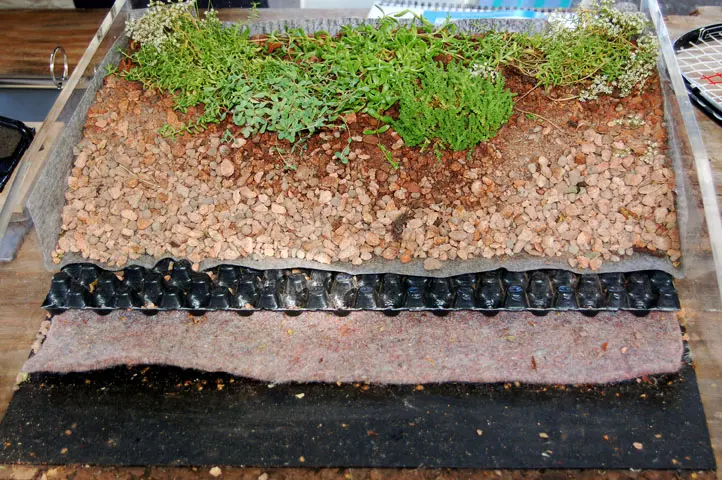
Green Roof Structure
Green roofs, marvels of eco-engineering, are more than just a layer of plants on a building.
They are complex systems, and with the components of a green roof, each layer plays a pivotal role in their functionality and sustainability.
Let’s dissect these layers to appreciate the ingenuity behind these living, breathing ecosystems on our urban rooftops.
Waterproofing Membrane: The Foundation
At the foundation of every green roof lies the waterproofing membrane.
This essential layer acts as a protective barrier, safeguarding the building from potential water damage.
It’s the unsung hero of the green roof system, ensuring longevity and structural integrity against the elements.
Root Barrier: Protecting the Structure
Above the waterproof membrane sits the root barrier. This crucial component prevents the roots of plants from digging too deep, potentially compromising the roof’s structural integrity.
It’s a fine balance between allowing plant growth and maintaining the roof’s health, a testament to the green roof design’s thoughtfulness.
The Growing Medium: Where Life Thrives
The growing medium, often mistaken for simple soil, is a specially engineered substrate.
It’s tailored for rooftop conditions, offering a nourishing yet lightweight environment for plants.
This layer is a key player in green roof construction, supporting a diverse range of vegetation adapted to this unique setting.
Drainage and Irrigation: Managing Water
An efficient drainage system is integral to green roof health, preventing waterlogging and ensuring excess water is swiftly removed.
In some cases, irrigation systems are added, especially in areas with less rainfall, to maintain optimal moisture levels.
These systems exemplify the precision behind green roof construction details.
Types of Green Roofs: Extensive vs. Intensive
Green roofs come in two main types: extensive and intensive.
Extensive roofs are lightweight, low-maintenance, and usually not accessible, ideal for smaller structures.
Intensive roofs, resembling traditional gardens, require more care but offer greater biodiversity and recreational space, showcasing the versatility of green roof systems residential and commercial alike.
The Environmental Benefits of Green Roofs
Introduction to Green Roof Benefits
Green roofs are not just an aesthetic addition to buildings; they’re environmental powerhouses.
These verdant spaces offer a plethora of benefits, from reducing urban heat islands to enhancing biodiversity.
Let’s explore how these living green roofs are making a significant impact on our urban environments.
Thermal Reduction and Energy Conservation
One of the key green roof benefits is their ability to reduce building temperatures.
By providing insulation, green roofs minimize heat loss in winter and reduce cooling needs in summer.
This thermal regulation translates into substantial energy savings, making buildings more energy-efficient and eco-friendly.
Stormwater Management: A Natural Solution
Green roofs excel in water management, especially in controlling stormwater runoff.
Their ability to absorb and retain rainwater reduces the burden on urban drainage systems.
This not only helps prevent flooding but also purifies the water, contributing positively to the urban water cycle.
Biodiversity and Ecological Enhancement
In the concrete jungles of our cities, green roofs provide much-needed habitats for wildlife.
They attract a variety of species, from birds to beneficial insects, creating pockets of biodiversity.
This not only enriches urban ecology but also fosters a connection between urban dwellers and nature.
Carbon Sequestration: Fighting Climate Change
Green roofs play a vital role in carbon sequestration, absorbing carbon dioxide from the atmosphere.
This contributes significantly to mitigating climate change effects.
The plants on green roofs capture carbon, storing it in their biomass and the soil, making them active participants in the global effort to reduce greenhouse gases.
Sound Insulation: A Quieter Environment
An often-overlooked benefit of green roofs is their ability to insulate buildings against noise.
The soil and plants effectively block lower and higher frequency sounds, providing a quieter, more serene environment.
This sound insulation is particularly beneficial in bustling urban areas, where noise pollution is a constant challenge.
How Do Green Roofs Work? Complete Guide – Sustainably Forward
Additional Advantages of Green Roofs
Enhancing Urban Aesthetics and Quality of Life
Beyond their environmental impact, green roofs significantly enhance urban aesthetics.
They transform bland rooftops into vibrant, green spaces, improving the overall quality of life for city residents.
These verdant havens offer a visual respite in the urban landscape, contributing to the psychological and social well-being of the community.
Contribution to Sustainable Building Certification
Green roofs contribute to sustainable building practices, often aiding in achieving LEED certification.
By meeting various environmental performance criteria, they enhance a building’s sustainability profile.
This not only reflects a commitment to ecological responsibility but also often results in financial incentives and recognition in the green building community.
Creating Additional Agricultural Space
In cities where space is at a premium, green roofs open new avenues for urban agriculture.
They provide valuable space for growing food, promoting local produce, and reducing food miles.
This innovative use of rooftop spaces supports sustainable food systems and encourages community engagement in urban farming initiatives.
Natural Water Filtration and Temperature Moderation
Green roofs act as natural filters for rainwater, purifying it before it joins urban water systems.
Additionally, they moderate the temperature of water runoff, mitigating thermal pollution in urban waterways.
This dual role of filtration and temperature regulation underscores green roofs’ multifaceted contribution to urban environmental management.
Recreational Opportunities and Community Engagement
Intensive green roofs, in particular, offer recreational spaces in urban settings.
These accessible rooftops can be designed as community gardens, leisure areas, or even event spaces, fostering community engagement and social interaction.
They provide urban dwellers with rare opportunities for outdoor activities and relaxation in densely populated areas.
Economic Implications of Green Roofs
Introduction to Green Roof Economics
While green roofs are celebrated for their ecological benefits, it’s equally important to consider their economic implications.
From initial installation costs to long-term financial impacts, understanding the economics of green roofs is crucial for homeowners, developers, and city planners alike.
Let’s delve into the cost-benefit analysis of green roofing.
Installation and Maintenance Costs
The initial cost of installing a green roof varies depending on its type – extensive or intensive.
While extensive roofs are generally more affordable and require less maintenance, intensive roofs, with their deeper soil and diverse plant life, demand a higher initial investment and ongoing care, influencing the green roof cost spectrum.
Roof Lifespan Extension and Durability
One of the significant financial benefits of green roofs is the extension of the roof’s lifespan.
By protecting the underlying structure from UV radiation and physical damage, green roofs can significantly prolong a roof’s life, often doubling or tripling its longevity.
This durability factor can lead to substantial cost savings over time.
Impact on Real Estate Value
Investing in a green roof can also enhance the real estate value of a property.
The aesthetic appeal, energy efficiency, and environmental benefits of green roofs make properties more attractive to prospective buyers or renters, potentially increasing the property’s market value, a factor worth considering in green roof building investments.
Energy Savings: A Long-Term Benefit
Green roofs contribute to energy conservation, leading to lower heating and cooling costs.
Their insulating properties help maintain a building’s internal temperature, reducing the need for artificial heating and cooling.
This energy efficiency is not only environmentally responsible but also translates into significant long-term cost savings for building owners.
Incentives and Rebates
Many regions offer financial incentives for green roof installation, such as tax reductions, grants, or rebates. These incentives are often provided in areas with environmental challenges like stormwater management issues or urban heat islands,
This makes the investment in green roofs more economically viable and attractive to property owners.
Challenges and Disadvantages of Green Roofs
Navigating the Downsides of Green Roofs
While green roofs offer numerous benefits, they also come with their own set of challenges and disadvantages.
It’s crucial for anyone considering a green roof to understand these potential downsides to make an informed decision.
Let’s explore the main challenges associated with green roofs.
Higher Initial Installation Costs:
- The cost of installing a green roof can be significantly higher than that of a conventional roof.
- Factors like the type of green roof, materials used, and structural reinforcements contribute to these costs.
Maintenance and Upkeep:
- Some types of green roofs, especially intensive ones, require regular maintenance such as watering, weeding, and repairing irrigation systems.
- Ongoing maintenance can add to the long-term costs of a green roof.
Structural Requirements and Limitations:
- Green roofs add extra weight to a building, which can be a significant factor, especially for older structures.
- Not all buildings are structurally suited for a green roof without additional reinforcement.
Potential for Pest Issues:
- The natural environment of a green roof can attract wildlife, including pest insects.
- This could pose a challenge, particularly in residential settings.
Increased Water Demand in Drier Climates:
- In areas with low rainfall, green roofs may require additional watering to maintain plant health.
- This can increase water usage and potentially negate some environmental benefits.
Complexity in Retrofitting Existing Buildings:
- Retrofitting an existing building with a green roof can be more complex and expensive than incorporating one into new construction.
- Structural assessments and modifications may be necessary to support the additional weight of the green roof.
Diverse Types of Green Roofs
Exploring the Variety of Green Roofs
Green roofs come in various forms, each designed to suit different needs and structural capabilities.
Understanding the types of green roofs is essential for choosing the right one for your building.
Let’s explore the diverse range of green roofs, from extensive to intensive, and their unique characteristics.
Extensive Green Roofs:
- Designed for minimal maintenance and accessibility.
- Support a lighter vegetation load (50–120 kg/m²).
- Ideal for residential buildings and smaller structures.
- Typically feature drought-resistant plants like sedum.
Intensive Green Roofs:
- Resemble traditional gardens with deeper soil.
- Can support a heavier vegetation load (390–730 kg/m²).
- Require more maintenance and are often accessible.
- Suitable for recreational spaces with a wider variety of plants.
Semi-Intensive Green Roofs:
- Combine elements of both extensive and intensive types.
- Offer a balance between weight, maintenance, and biodiversity.
- Can include a mix of lightweight and deeper planting areas.
- Provide more flexibility in design and plant selection.
Specialized Green Roofs:
- Include variations like biodiverse roofs, which aim to recreate specific natural habitats.
- Some feature rooftop farming or are tailored for urban agriculture.
- Others are designed with advanced water management systems for sustainability.
Green Roof Innovations:
- Advancements in technology are leading to new green roof designs.
- These include modular systems, lightweight materials, and smart irrigation.
- Future developments may focus on enhancing energy efficiency and environmental benefits.
Historical Perspective of Green Roofs
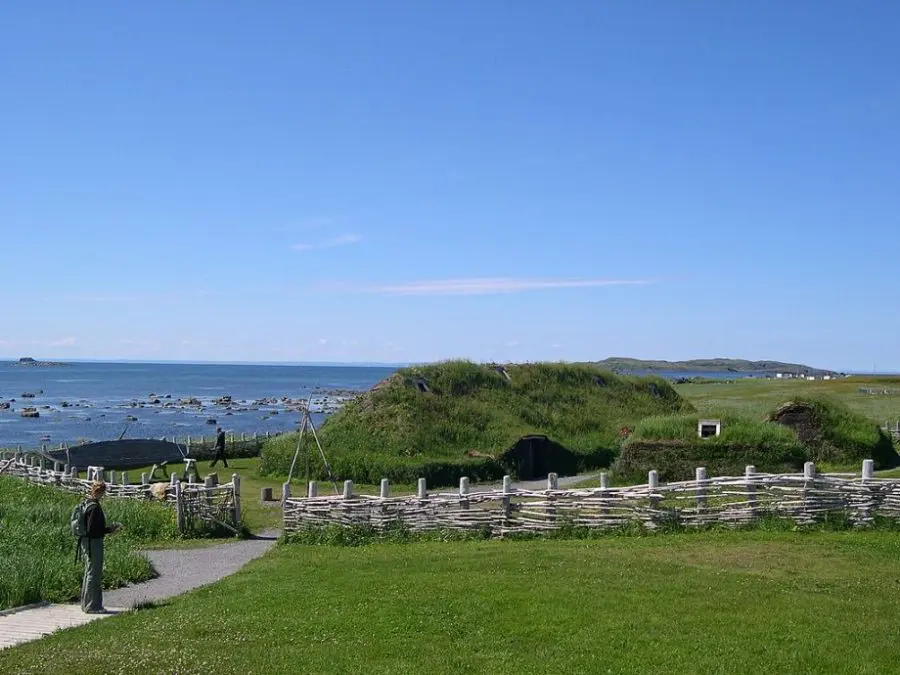
Tracing the Roots of Green Roofing
Green roofs are not a modern invention; they have a rich history that spans centuries and cultures.
Understanding their historical evolution provides insight into how they’ve become an integral part of contemporary sustainable architecture.
Let’s journey through time to explore the origins and development of green roofs.
Ancient Green Roofs:
- Early examples were simple, earth-covered structures, often used in rural settings for insulation and protection.
- These rudimentary green roofs provided both a living space and a space for agriculture.
- Examples include sod roofs in Scandinavia and earth-sheltered homes across various cultures.
Evolution in the Middle Ages and Beyond:
- As construction techniques evolved, so did the complexity and functionality of green roofs.
- Medieval and Renaissance gardens on rooftops were precursors to today’s intensive green roofs.
- These spaces were not only functional but also symbolized wealth and status.
Industrial Age to Modern Times:
- The Industrial Revolution brought new materials and building techniques, leading to a decline in traditional green roofs.
- However, the environmental movement in the 20th century sparked renewed interest in green roofs for their ecological benefits.
- Advances in waterproofing and structural engineering in the 1960s and 70s led to the modern green roof systems we see today.
Contemporary Green Roof Movement:
- Today’s green roofs are highly engineered, combining sustainability with aesthetics.
- They are an essential component of urban planning, addressing environmental issues like urban heat islands and stormwater management.
- Green roofs have become a symbol of modern eco-conscious design, embraced by cities worldwide.
Maintenance and Long-Term Care: Ensuring Green Roof Longevity
Keeping Your Green Roof Thriving
Maintaining a green roof is crucial for its longevity and effectiveness. It’s not just about installing; it’s about nurturing.
Regular maintenance ensures that your green roof remains a vibrant, functional space.
Let’s delve into the key practices and solutions for maintaining your green roof and addressing common issues.
Regular Inspection and Debris Removal:
- Conduct periodic inspections to check for blockages in drainage areas.
- Remove debris like fallen leaves and branches to prevent water pooling and root rot.
Weed Control and Plant Health:
- Monitor and control weed growth to prevent invasive species from overtaking the roof.
- Keep an eye on plant health; replace any plants that aren’t thriving.
Irrigation System Maintenance:
- Check and maintain irrigation systems, if installed, to ensure efficient watering.
- Adjust watering schedules seasonally to meet the plants’ needs without overwatering.
Fertilization for Nutrient Balance:
- Apply fertilizer sparingly to avoid excessive growth and additional weight on the roof.
- Use slow-release, low-nitrogen fertilizers to maintain a balance of nutrients.
Addressing Structural Issues Promptly:
- Look out for signs of wear in the waterproof membrane or any structural damage.
- Early detection and repair of such issues can prevent more significant problems.
Preparing for Seasonal Changes:
- In colder climates, protect the roof from frost damage and ensure it can withstand the weight of snow.
- In hot climates, ensure adequate shade and moisture retention to combat extreme heat.
Professional Check-ups:
- Consider scheduling annual or bi-annual check-ups with a green roof professional.
- Professional maintenance can address complex issues and provide expert care.
By adhering to these maintenance guidelines, your green roof can remain a healthy, sustainable, and beautiful addition to your building for years to come.
FAQs: Understanding Green Roofs
Green roofs, a fascinating blend of nature and architecture, often spark curiosity and questions.
Whether you’re a homeowner considering a green oasis atop your roof, a developer integrating sustainable practices, or simply an eco-conscious individual, understanding the nuances of green roofs is crucial.
In this section, we address some of the most frequently asked questions about green roofs.
From their impact on property value to the practicalities of installation and maintenance, these answers aim to shed light on the key aspects of green roofing, helping you make informed decisions about this environmentally friendly roofing option.
Q. What is the disadvantage of a green roof?
A. Green roofs have several advantages, but they do come with drawbacks.
The most notable is the higher initial cost compared to traditional roofing.
Additionally, depending on the type, they can require more maintenance, and there are structural considerations since they add weight and require a robust waterproofing system.
Q. Do green roofs cost more?
A. Yes, green roofs generally cost more upfront than conventional roofs.
This is due to the additional materials needed, such as waterproofing layers, drainage systems, and planting mediums.
However, they can offer long-term financial benefits through energy savings and increased roof longevity.
Q. Can you put a green roof on a regular house?
A. Absolutely! Green roofs can be installed on various structures, including regular houses.
However, it’s crucial to ensure that the house can support the additional weight and has a suitable waterproofing system.
Extensive green roofs are often more suitable for residential settings due to their lighter weight and lower maintenance requirements.
Q. What are the 3 types of green roofs?
A. The three main types of green roofs are extensive, intensive, and semi-intensive.
Extensive green roofs are lightweight and low-maintenance, intensive green roofs are heavier, require more care, and can support a wider range of plants, while semi-intensive roofs offer a balance between the two.
Q. Can any roof be a green roof?
A. Not all roofs are suitable for green roof conversion. Factors such as the roof’s structural capacity, slope, and existing waterproofing must be considered.
While many roofs can be adapted for green roofing, some may require significant modifications or might not be suitable at all.
Q. Do green roofs last?
A. Green roofs often extend the lifespan of the roofing structure by protecting it from UV rays and temperature fluctuations.
Properly installed and maintained green roofs can last as long, if not longer, than traditional roofs, offering a sustainable roofing solution.
Q. What is the biggest limitation to having a green roof?
A. The biggest limitation is often the structural capacity of the existing building.
Green roofs add weight, and not all buildings can support this without reinforcement.
Additionally, the cost, both initial and ongoing, can be a limiting factor for some projects.
Q. Why aren’t green roofs more popular?
A. The slower adoption rate of green roofs can be attributed to higher upfront costs, the need for specialized knowledge in installation and maintenance, and structural challenges in retrofitting existing buildings.
However, as awareness of their environmental benefits grows, their popularity is steadily increasing.
Q. Do green roofs increase property value?
A. Yes, green roofs can increase property value. They enhance the aesthetic appeal of a building, improve energy efficiency, and offer unique functional spaces, all of which are attractive features in the real estate market.
This can make properties with green roofs more desirable and valuable.
Conclusion: Embracing the Green Roof Revolution
As we conclude our comprehensive exploration of green roofs, it’s clear that they represent more than just an architectural trend; they are a vital component of sustainable urban development.
Green roofs are an innovative solution to many environmental challenges faced by modern cities, from reducing urban heat islands to enhancing biodiversity.
Learn more: Why do we need green roofs?
Let’s summarize the key takeaways from our journey into the world of green roofs.
Sustainable Urban Ecosystems:
- Green roofs are pivotal in creating sustainable, resilient urban ecosystems.
- They offer a unique blend of environmental benefits, including improved air quality, energy efficiency, and natural habitat creation.
Architectural and Aesthetic Appeal:
- Beyond their environmental impact, green roofs add significant architectural and aesthetic value to buildings.
- They transform unused rooftop spaces into visually appealing and functional areas, enhancing the overall urban landscape.
Economic and Practical Considerations:
- While there are economic considerations such as initial installation costs and maintenance, the long-term benefits, including extended roof life and potential property value increase, make green roofs a worthwhile investment.
Future of Urban Living:
- As cities continue to grow and face ecological challenges, green roofs stand out as a practical solution for sustainable urban living.
- They are a testament to our ability to harmoniously integrate nature into our built environment.
In embracing green roofs, we take a significant step towards a greener, more sustainable future.
Whether you’re a homeowner, architect, or city planner, the potential of green roofs to transform our urban spaces is undeniable.
They are not just a feature of the present but a cornerstone of future urban planning, signifying our commitment to environmental stewardship and sustainable living.
Green Roofs and Living Walls: Easily Learn the Difference – Sustainably Forward

